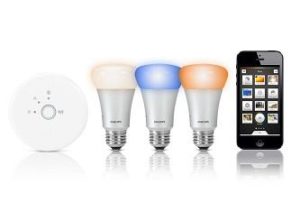 Like door locks, security systems, and home appliances, the humble light bulb has undergone a “smart” revolution in recent years. Today, you can now replace your classic incandescent light bulb—whose design has remained relatively unchanged for more than 100 years—with a wide range of connected LED lighting solutions that you can switch on and off, change color, and dim from your mobile device.
Like door locks, security systems, and home appliances, the humble light bulb has undergone a “smart” revolution in recent years. Today, you can now replace your classic incandescent light bulb—whose design has remained relatively unchanged for more than 100 years—with a wide range of connected LED lighting solutions that you can switch on and off, change color, and dim from your mobile device.
It’s for this reason that smart LED lighting comes at a higher price tag than ordinary light bulbs. Besides using light-emitting diodes, smart bulbs come with additional technologies that allow them to perform several functions aside from just generating light.
In this guide, we give you a quick rundown of these functions, which should help you make an informed decision on whether to replace your [city] home’s light bulbs with smart LEDs.
1. Dimmability
Dimmability isn’t exactly a new feature; we’ve been able to dim and brighten incandescent light bulbs for years. But this didn’t do much to make them more energy efficient. Dimming is also practically impossible with compact fluorescent lights (CFLs), as their design is simply incompatible with the mechanism required to dim and brighten a light bulb—it involves reducing the current of electricity being fed to the device.
In contrast, LEDs work just fine with dimming controllers. But smart LEDs take it even further, allowing you to control their lighting output using the corresponding app on your phone or tablet.
2. Remote Control
Pretty much all smart LED light bulbs on the market have remote control as one of their key features. By connecting to your wireless network, the bulbs can be linked through a hub, which in turn links to the proprietary app on your smartphone or tablet device.
Other smart LEDs take things a notch higher by letting you create schedules that automatically switch on and switch off your lights, even when nobody is around. It’s a useful safety feature when you’re out of the country, for example, and want to make it seem that someone’s at home.
3. Changing Colors on the Fly
Dimming your [city] home’s lights is cool, but how about changing their colors and giving your home an entirely new look? Many smart LED bulbs are designed to generate several colors. Bulbs like the Flux Smart LED and the Philips Hue generate more than 16 million colors, which you can choose from using the app.
The ability to change the color of your home lighting isn’t just a neat trick; it has several useful applications.
If you’re entertaining guests for dinner or a party, you can soften your lights by changing them to a warm yellow, which will create a soft and relaxed mood. On the other hand, if you want to increase alertness and productivity, such as when you’re cooking in the kitchen or working on a DIY project in the garage, you can switch to a white light similar to daylight at noon.
Smart LED light bulbs may seem like a fad, but the same can also be said for ordinary LED bulbs when they first burst into the scene. While it’s true that they’re expensive, all new technology starts out this way. The good news is that prices will eventually go down in time if you’d rather wait. For now, you can start with a few smart bulbs in your home to see for yourself what they have to offer.

![[city] Area Business to Rethink Commercial and Retail Lighting Strategies in 2020 [city]](https://eepros.com/wp-content/uploads/2020/05/building-1210022_640-300x200.jpg)
![5 LED Myths You Need to Stop Believing Today [city]](https://8blocks.s3.amazonaws.com/eepros/blog-images/2015/03/ledbulb-300x168.jpg)
![6 Secrets of Office Lighting That Help Workers Stay Productive [city]](https://eepros.com/wp-content/uploads/2019/02/light-1603766_640-300x200.jpg)
![Why Choose Outdoor LED Lighting For Your Business? [city]](https://8blocks.s3.amazonaws.com/eepros/blog-images/2014/08/ledlighting-300x181.jpg)